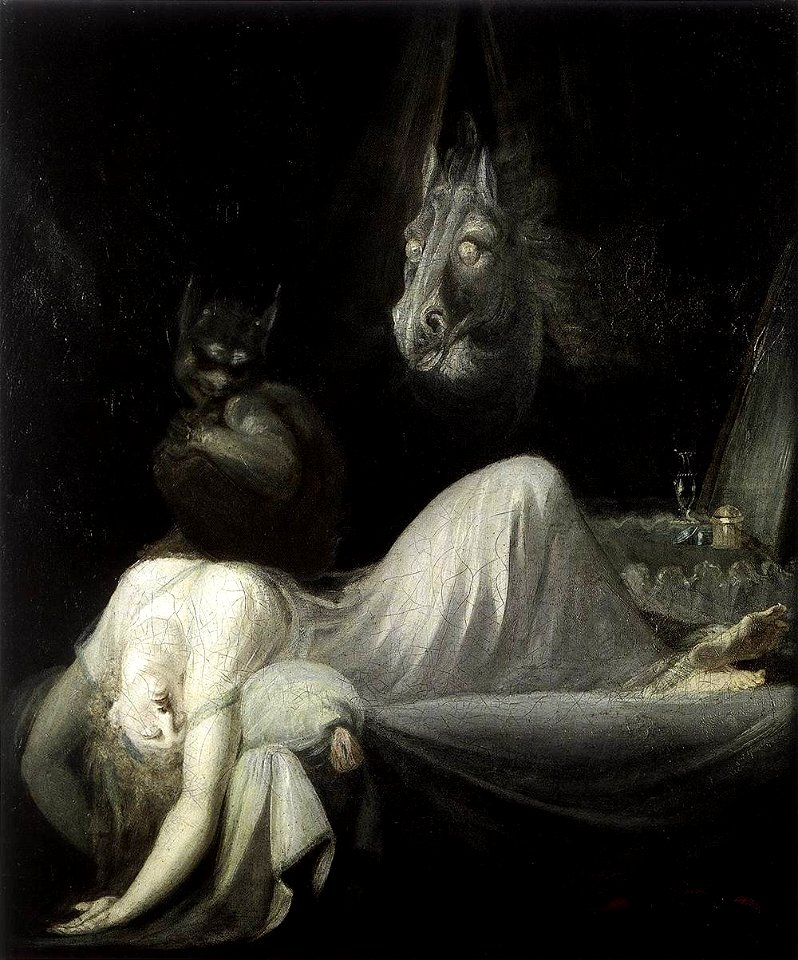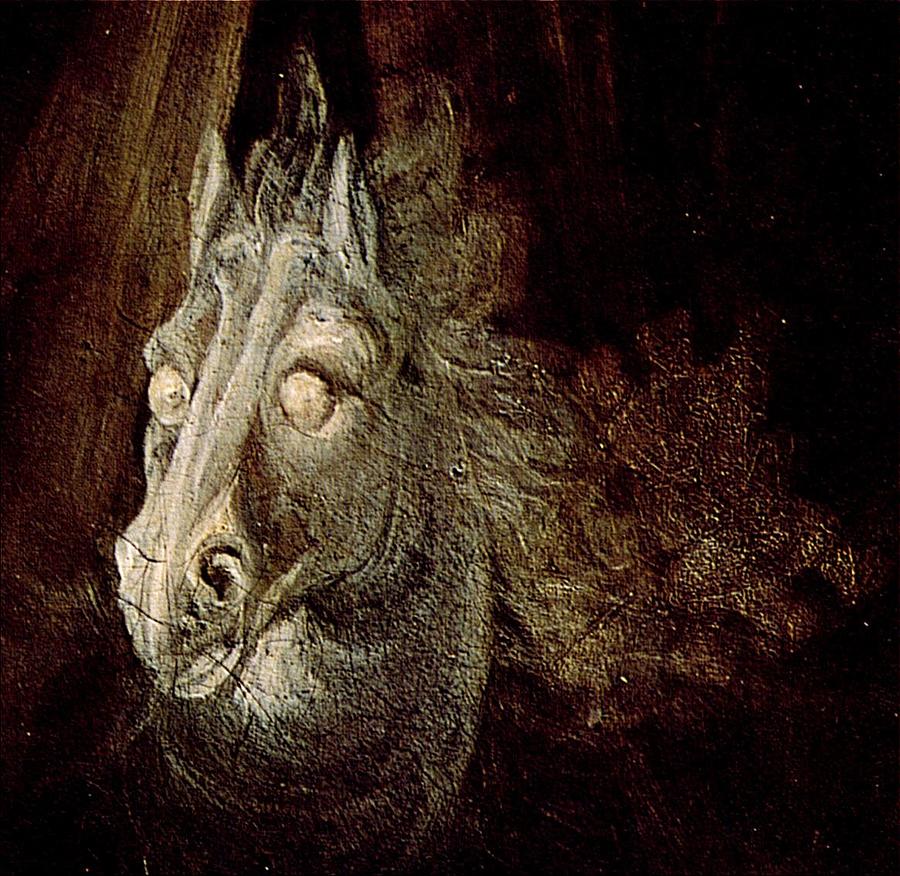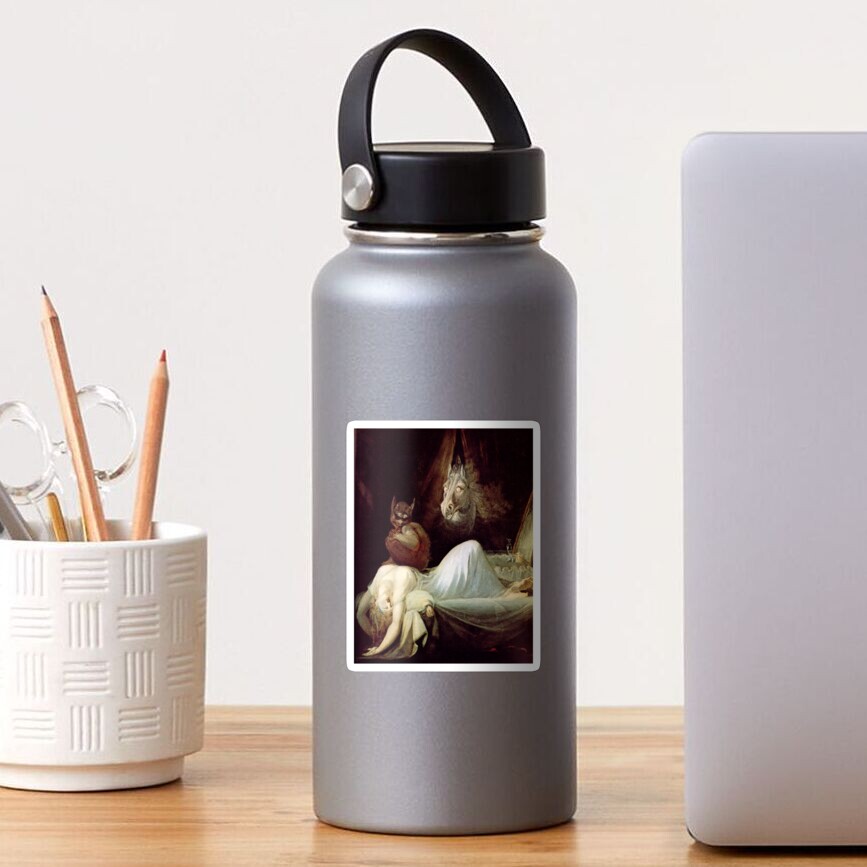
Christ Disappearing at Emmaus — Henry (Fussli Fuseli
The Nightmare, oil painting that was created in 1781 and is Swiss-born artist Henry Fuseli 's most famous painting, as well as a landmark in the development of the Romantic movement. It has become an iconic image that is familiar in popular culture and much parodied.

Henry Fuseli Artist, Illustrators, Painting
In any event, it is unquestionable that Fuseli's most renowned painting is The Nightmarey about which, accordingly, there is much modern scholarship (Chappell; Janson; Kaiman; Moffitt, "Malleus"; Powell; Schneck). Painted in 1781, it quickly became immensely popular after being exhibited at the Royal Academy in London the following year.

The nightmare Fussli Summaries English Docsity
The Nightmare, one of Fuseli's most famous paintings, interprets the psychology with two punning images: a "mare" (female goblin) presses heavily the womb of a dreamer, a spectacle on which a "mare" (female horse) gazes with blind or visionary eyes.

The magic of the Art history, Art, Romanticism
'The Nightmare' Fuseli's most famous painting is 'The Nightmare, painted in 1781, which caused something of a sensation and a scandal when he first exhibited it at the Royal Academy of London in 1782.

Johann Heinrich Füssli The Nightmare WGA08333 Free Stock
Henry Fuseli RA (German: Johann Heinrich Füssli; 7 February 1741 - 17 April 1825) was a Swiss painter, draughtsman and writer on art who spent much of his life in Britain. Many of his works, such as The Nightmare, deal with supernatural subject-matter. He painted works for John Boydell's Shakespeare Gallery, and created his own "Milton Gallery".
.jpg?mode=max)
Johann Heinrich Füssli, Henry Fuseli, R.A. (Zurich 17411825 Putney Hill)
This week we study a piece from the Anglo-Swiss artist Henry Fuseli that typifies the symbolism and complexity of artistic Romanticism
,-Les-trois-sorcières,-après-1783,.jpg)
神秘的かつ幻想的なゴシックロマン主義 パリ フュースリー展KKHBRIDGE 文化の枠を越えるメディア
The Nightmare. When English author Horace Walpole saw this painting at the Royal Academy in London in 1782, he used one word to describe it: "shocking.". Owned by Richard Mansergh St. George's best friend, Sir Brooke Boothby, Henry Fuseli's The Nightmare dismayed some critics. It depicted an imagined sensation, not something real or.

Il Caffé dell'Arte Johann Heinrich Füssli La Follia Di Kate 18061807
The Nightmare by Henry Fuseli, 1781, via the Detroit Institute of Arts . Henry Fuseli (Johann Heinrich Füssli) was an Anglo-Swiss painter (1741-1825) who was more well known in his lifetime for his art history lectures and writing rather than his artwork. However, The Nightmare by Henry Fuseli would gain notoriety in the art world after its exhibition in the Royal Academy in the summer of 1782.

Claroscuro Johann Heinrich Füssli
A mare, or mara, is an evil night spirit that torments humans in their sleep. Samuel Johnson defined the mare in A Dictionary of the English Language (1755) as: [A] spirit that, in heathen mythology, was related to torment or to suffocate sleepers. Morbid oppression in the night resembling the pressure of weight upon the breast. Samuel Johnson

The Nightmare by Johann Heinrich Fussli of horse Nachtmahr Detail Pferd
A brief discussion about the painter Henry Fuseli and the painting that cemented his career as an artist, The Nightmare. Topics touched on include the subjec.

"Vintage Johann Heinrich Fussli The Nightmare 1790" Sticker for Sale by
Henry Fuseli The Nightmare exhibited 1782 Gothic Nightmares explores the work of Henry Fuseli (1741-1825) and William Blake (1757-1827) in the context of the Gothic - the taste for fantastic and supernatural themes which dominated British culture from around 1770 to 1830.

"Vintage Johann Heinrich Fussli The Nightmare 1790" Sticker for Sale by
As Samuel Johnson's A Dictionary of the English Language (1755) defined it, a mare or "mara, [is] a spirit that, in heathen mythology, was related to torment or to suffocate sleepers. A morbid oppression in the night resembling the pressure of weight upon the breast."

Traum, frei nach J. H. Füsslis Nightmare Postkarte VE 10 Orell Füssli
The Nightmare is a 1781 oil painting by Swiss artist Henry Fuseli. It shows a woman in deep sleep with her arms thrown below her, and with a demonic and ape-like incubus crouched on her chest. The painting's dreamlike and haunting erotic evocation of infatuation and obsession was a huge popular success.

https//flic.kr/p/25no1kq Henry Fuseli, Milton Dictating to His
As Samuel Johnson's A Dictionary of the English Language (1755) defined it, a mare or "mara, [is] a spirit that, in heathen mythology, was related to torment or to suffocate sleepers. A morbid oppression in the night resembling the pressure of weight upon the breast."

Johann Heinrich Füssli (o Fuseli). La pesadilla (o El Íncubo) {ART
The Nightmare is a 1781 oil painting by Anglo-Swiss artist Henry Fuseli. It shows a woman in deep sleep with her arms thrown below her, and with a demonic and apelike incubus crouched on her chest. The painting's dreamlike and haunting erotic evocation of infatuation and obsession was a huge popular success.
The Changeling by Henry Fuseli (Johann Heinrich Füssli) (17411825
Henry Fuseli's The Nightmare is an 18th-century artwork that created a sensation amongst contemporary critics for its terrifying and creepier sexual depiction. This painting portrays a woman in.